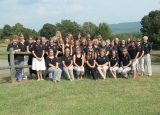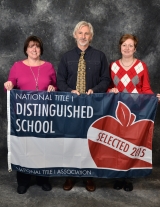-
Category 1
Selected in 2015
-
Grades: pre k - 5
School Setting: rural
Town Population: 0
Student Enrollment: 220
Student Demographics:
Black/African American: 15%
Teacher/Student Ratio: 1:17
White/Caucasian: 80%
Hispanic: 5%
Hawaiian/Pacific Islander: 0%
Asian: 0%
Native American: 0%
Other: 0%
% Reduced Lunch: 63%
% ELL Learners: 1%
Founded: 1934 -
PRINCIPAL:
Kenneth Grindstaff -
CONTACT:
5393 Snow Creek Road
Penhook, VA 24137
540-483-5599
ken.grindstaff@frco.k12.va.us
Snow Creek Elementary School
Penhook, VA
An integral strategy that Snow Creek has implemented for the last several years is daily What I Need time (WIN). Homeroom teachers, two paraprofessionals, and an intervention teacher regularly assess student performance and provide small group instruction, differentiated to ensure relevance and challenge for each student.
- What is the single most important factor in the success of your school that others could replicate?
-
An integral strategy that Snow Creek has implemented for the last several years is daily What I Need time (WIN). Homeroom teachers, two paraprofessionals, and an intervention teacher regularly assess student performance and provide small group instruction, differentiated to ensure relevance and challenge for each student. Some students receive remediation and reinforcement; others may need more intensive or individualized interventions, while others may have mastered a concept and need academic enhancement. WIN time is built into the master schedule at every grade level, every day.
An integral part of the WIN time is the Response to Intervention process. It is a multi-tiered framework of academic and behavioral supports which provides strategic and intensive intervention. An intervention teacher provides the academic supports with individualized instruction to students with the greatest need, using research-based programs and strategies outside the core instruction. The behavioral supports are provided through guidance counselors, school social workers and day treatment workers.
- Describe the program or initiative that has had the greatest positive effect on student achievement, including closing achievement or opportunity gaps, if applicable.
-
Our reading program has had the most positive effect on our students. We feel success in reading is crucial for success in other subjects. Students are provided ninety minutes of daily reading instruction for every child, every day. A research-based curriculum is used that emphasizes reading, writing, and oral language in skill-leveled groups rather than age-based groups. This design allows strong readers to move into more complex text while providing the structure and support for struggling readers.
For Kindergarten students, teachers use a structured sequence to introduce letters and sounds, which are then combined as they learn to read words, sentences, and stories. They experience storytelling and retelling to develop oral language skills. Phonological and phonemic awareness are developed through read-alouds, partner reading, and independent reading. As students progress into first grade, they also move into systematic phonics instruction, along with instruction in fluency and comprehension, and are introduced to decoding strategies for unknown words.
While many learners beyond first grade still need direct instruction/support in phonics, emphasis in reading instruction is shifted to the core comprehension strategies of clarifying, questioning, predicting, and summarizing. Narrative or expository trade books, carefully chosen for relevance and content, are used to build background knowledge, vocabulary, fluency, comprehension, team discussion, and writing ability. Students answer questions with verbal and written responses using complex sentences structured with the question stem and evidence from the text.
- Identify the critical professional development activities you use to improve teaching and student learning.
-
A. G. Bell stated, “Preparation is the key to success”. In order for teachers to instruct students to the best of their ability, they are encouraged to attend conferences and classes that will help prepare them to deliver engaging and research-based instruction. Conferences are chosen which align with the school improvement plan or which will help a particular teacher grow. Afterwards, they are expected to present at faculty meetings to share the new strategies or insights with the rest of the faculty. This sustained commitment to ongoing professional development keeps Snow Creek teachers informed and skilled in best practices.
The implementation of the reading curriculum was a crucial piece to Snow Creek’s success. Putting the program into place required a great deal of professional development, not only for the reading instruction element, but also for classroom set-up and management. The instructional coach provided on-going, embedded support as the school moved from mechanical implementation to full and refined implementation. Each teacher progressed at a different rate and needed differentiated support. Some needed only encouragement and feedback, while others needed the coach to model implementation. Meetings between the instructional coach, principal, and the company’s point coach identify areas that can be refined, and annual improvement plans are developed.
Professional development at the district and school level has been focused on student engagement, and the alignment of questioning and performance tasks with the cognitive expectations of Virginia Standards of Learning. Using a math evaluation tool, the faculty spent time discussing and defining what student engagement is and what evidence in the classroom would be. They then used the tool to evaluate two teachers on an educational video. The discussion continued and teachers developed a common understanding of student engagement. The tool is now used by the principal for walk-throughs.
In addition, the faculty and staff conducted a book study of Essential Questions by McTighe and Wiggins. Walk-through data and quarterly meetings with the principal and the instructional coach serve as support and a means of gathering feedback as teachers plan, design and reflect on lessons intended to engage students, and to construct open-ended questions and meaningful tasks.
Snow Creek School routinely has a free and reduced lunch rate of 63-69%. Recognizing that students from high-poverty areas have specific needs, plans were made for all teachers to attend a Ruby Payne workshop to help them identify and address these special needs.
The principal has developed a teachers-only website to provide the opportunity for them to read and comment on relevant professional articles. - Describe how data is used to improve student achievement and inform decision making.
-
Snow Creek understands data to be a form of communication which is essential in decision-making for improvement. Each grade level contributes to Snow Creek’s School Improvement Plan by working with baseline data to set student performance goals and the action steps needed to move students toward achieving indicators of success. These indicators are defined as quarterly benchmarks in each of the areas of reading (phonemic awareness, phonics, comprehension, fluency) and in writing and mathematics.
Teachers use formative assessments to measure students’ understanding of lessons and to adapt their instructional plans as needed. Performance tasks, exit slips, projects, quizzes, journals and reading inventories that use a computer-based assessment design serve as progress-monitoring tools which help to determine students’ reading level.
Student growth is also evaluated through summative assessments. In addition to common unit tests, district-level benchmark tests are administered twice a year; these provide the data necessary to disaggregate by SOL strand or question. Students who score below 80% must conference with their teachers to determine where misunderstandings occurred and to help correct mistakes. Information from this session determines how students are grouped for WIN, (What I Need), time.
The results of all assessments are shared with families through weekly folders, phone calls and notes sent home, and are retained for use in conferring with parents regarding student needs and strengths. Parents can also access grades through a web-based Parent Portal.
Parents and the community are kept abreast of Virginia Standard of Learning assessment results, as well as attendance and disciplinary trends, through postings on the school website and school bulletin boards. Public meetings are scheduled to discuss the overall scores, including the value and implications of testing results for individual students, and the significance of testing data in the school planning process.
- Describe your school culture and explain changes you’ve taken to improve it.
-
The atmosphere and climate at Snow Creek are welcoming to students, parents, and staff members. Each day begins with the principal and other staff members greeting students as they enter the building. Students are then met by support staff in the hallways and by teachers at their classroom doors. If students choose to eat breakfast, they get to share the meal with staff members.
Students have a sense of belonging and ownership of the school. Each morning several students join the principal in the office to help with the morning announcements, excited to share jokes, short stories, or poems with the entire school. Fifth graders have the opportunity to demonstrate their respect by raising and lowering the flags daily. Students’ work is showcased on the walls in the hallways, cafeteria, and classrooms.
Snow Creek staff members provide explicit instruction and actively seek to motivate the students to take responsibility for their own learning, to develop healthy self-esteem, and to respect and appreciate each other’s differences. Students routinely work in teams to develop weekly goals, and then they learn to set individual achievement goals in reading and in mathematics. For example, in the Accelerated Reader program, they are rewarded for reading books they choose from an age-approved list. The school provides incentives that are used to celebrate the successful completion of monthly and yearly reading goals.
For the inevitable times of family crisis or learning issues, Snow Creek has established a school-wide Solutions Team, which includes the guidance counselor, a school social worker, the instructional coach, the principal and teachers. Such difficult situations can affect children academically, socially, and emotionally, impacting not only their academic world, but their general wellness and growth. The Solutions Team works with students and families in five areas (Attendance, Interventions, Parent and Family Involvement, Community Connections and Cooperative Culture) to create supports and promote positive solutions for these individual needs.
The culture of valuing and investing in others does not stop with the students; the principal supports the teachers by provided time for them to collaborate, plan and discuss ways to help students achieve their very best. They are encouraged to attend conferences and professional development sessions to update and reinforce best practices.
The principal, teachers, and support staff share the constant values and beliefs that students will succeed in school and in life, and they work together to ensure that Snow Creek’s positive climate and culture make it a place where that can happen.
Stats
-
Category 1
Selected in 2015
-
Grades: pre k - 5
School Setting: rural
Town Population: 0
Student Enrollment: 220
Student Demographics:
Black/African American: 15%
Teacher/Student Ratio: 1:17
White/Caucasian: 80%
Hispanic: 5%
Hawaiian/Pacific Islander: 0%
Asian: 0%
Native American: 0%
Other: 0%
% Reduced Lunch: 63%
% ELL Learners: 1%
Founded: 1934 -
PRINCIPAL:
Kenneth Grindstaff -
CONTACT:
5393 Snow Creek Road
Penhook, VA 24137
540-483-5599
ken.grindstaff@frco.k12.va.us










